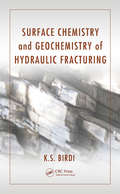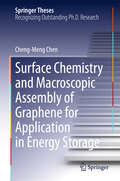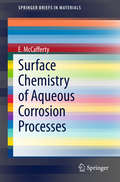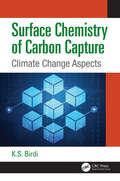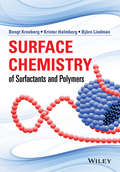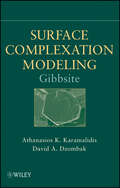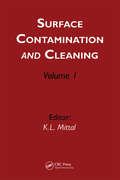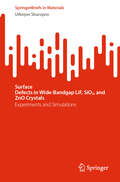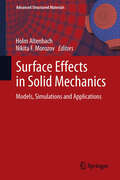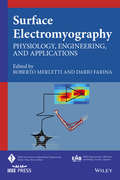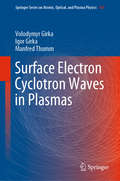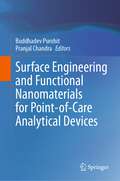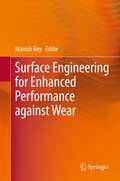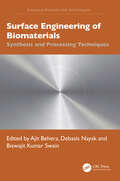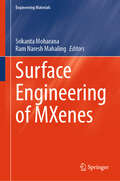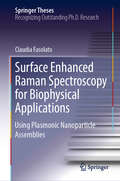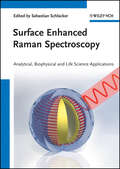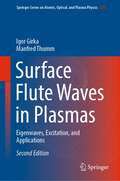- Table View
- List View
Surface Chemistry and Geochemistry of Hydraulic Fracturing
by K. S. BirdiUnique in focus, Surface Chemistry and Geochemistry of Hydraulic Fracturing examines the surface chemistry and phenomena in the hydrofracking process. Under great scrutiny as of late, the physico-chemical properties of hydrofracking are fully detailed and explained. Topics include the adsorption-desorption of gas on the shale reservoir surface and relevant waste-water treatment dependent on various surface chemistry principles. The aim of this book is to help engineers and research scientists recognize the basic surface chemistry principles related to this subject. Written by a long-time expert in the field, this book presents an unbiased account of the hard science and engineering involved in a resource that is gaining growing attention within the community.
Surface Chemistry and Macroscopic Assembly of Graphene for Application in Energy Storage
by Cheng-Meng ChenThis PhD thesis presents the latest findings on the tunable surface chemistry of graphene/graphene oxide by systematically investigating the tuning of oxygen and nitrogen containing functional groups using an innovative carbonization and ammonia treatment. In addition, novel macroscopic assemblies or hybrids of graphene were produced, laying the theoretical foundation for developing graphene-based energy storage devices. This work will be of interest to university researchers, R&D engineers and graduate students working with carbon materials, energy storage and nanotechnology.
Surface Chemistry of Aqueous Corrosion Processes
by E. MccaffertyThis SpringerBrief utilizes a surface chemistry/physical chemistry approach toward the study of aqueous corrosion processes. The book starts with a timely and in-depth review of Acid-Base Properties of Surface Oxide Films. Acid-base properties are significant in various surface phenomena such as general and localized corrosion, corrosion inhibition by organic molecules, and the adhesion of organic polymers to oxide-covered metals. This review also discusses the relationship between the two measures of surface charge, the isoelectric point of the oxide film and the potential of zero charge of the oxide-covered metal. Other topics included are capillarity and corrosion, corrosion inhibition, passivity of Fe-Cr and Fe-Cr-Ni alloys, the uptake of chloride Ions and the pitting of aluminum, and the formation of water films on the iron oxide surface.
Surface Chemistry of Carbon Capture: Climate Change Aspects
by K. S. BirdiSurface Chemistry of Carbon Capture: Climate Change Aspects provides comprehensive and up-to-date literature on carbon capture and storage (CCS) technology and delineates the surface chemistry of this process. Mankind is dependent on energy from gas, oil, coal, atomic energy, and various other sources. In all fossil fuel combustion processes, carbon dioxide (CO2) is produced (ca. 25 Gt/year). In the past few decades, we have observed a constant increase in CO2 content in the air (currently ca. 400 ppm [0.04%]). This book discusses the technology related to carbon (i.e., CO2) capture and sequestration (CCS) from fossil fuel energy plants, which is considered an important means of CO2 control. It also covers the adsorption/absorption processes of CO2 on solids and similar procedures to help address growing climate change concerns.
Surface Chemistry of Surfactants and Polymers
by Bengt Kronberg Krister Holmberg Bjorn LindmanThis book gives the reader an introduction to the field of surfactants in solution as well as polymers in solution. Starting with an introduction to surfactants the book then discusses their environmental and health aspects. Chapter 3 looks at fundamental forces in surface and colloid chemistry. Chapter 4 covers self-assembly and 5 phase diagrams. Chapter 6 reviews advanced self-assembly while chapter 7 looks at complex behaviour. Chapters 8 to 10 cover polymer adsorption at solid surfaces, polymers in solution and surface active polymers, respectively. Chapters 11 and 12 discuss adsorption and surface and interfacial tension, while Chapters 13- 16 deal with mixed surfactant systems. Chapter 17, 18 and 19 address microemulsions, colloidal stability and the rheology of polymer and surfactant solutions. Wetting and wetting agents, hydrophobization and hydrophobizing agents, solid dispersions, surfactant assemblies, foaming, emulsions and emulsifiers and microemulsions for soil and oil removal complete the coverage in chapters 20-25.
Surface Complexation Modeling: Gibbsite
by David A. Dzombak Athanasios K. KaramalidisThis book provides a description of the generalized two layer surface complexation model, data treatment procedures, and thermodynamic constants for sorption of metal cations and anions on gibbsite, the most common form of aluminum oxide found in nature and one of the most abundant minerals in soils, sediments, and natural waters. The book provides a synopsis of aluminum oxide forms and a clearly defined nomenclature. Compilations of available data for sorption of metal cations and anions on gibbsite are presented, and the results of surface complexation model fitting of these data are given. The consistency of the thermodynamic surface complexation constants extracted from the data is examined through development of linear free energy relationships which are also used to predict thermodynamic constants for ions for which insufficient data are available to extract constants. The book concludes with a comparison of constants extracted from data for sorption on gibbsite with those determined previously for hydrous ferric oxide (HFO), hydrous manganese oxide (HMO), and goethite.The overall objective of this book is the development and presentation of an internally consistent thermodynamic database for sorption of inorganic cations and anions on gibbsite, an abundant and reactive mineral in soils, sediments, and aquatic systems. Its surface has a high affinity for sorption of metal cations and anions, including radionuclides. The gibbsite database will enable simulation and prediction of the influence of sorption on the fate of these chemical species in natural systems and treatment processes in which aluminum oxides are abundant. It thus will help to advance the practical application of surface complexation modeling.
Surface Contamination and Cleaning: Volume 1
by K. L. MittalThis volume documents the proceedings of the International Symposium on Surface Contamination and Cleaning, held in Newark, New Jersey, May 23-25, 2001. Because of the importance of this topic in many technological areas, tremendous efforts have been devoted to devise novel and more efficient ways to monitor, analyse and characterize contamination
Surface Defects in Wide-Bandgap LiF, SiO2, and ZnO Crystals: Experiments and Simulations (SpringerBriefs in Materials)
by Utkirjon SharopovThis book deals with surface defects in wide-bandgap crystals of lithium fluoride, silicon dioxide, and zinc oxide. Encompassing topics such as radiation-induced amorphization, crystallization, and various microstructural developments arising from defect production and annealing, the book delves into controlled modifications of physical and chemical properties, micro and nano-structuring of surfaces, and the creation and behavior of structures far from thermal equilibrium, including supersaturated solid solutions, ion tracks, and surfaces treated with electron- and high-intensity ion beams. Beyond its relevance to the academic community, this monograph serves as a valuable resource for design and installation organizations, offering insights for specialists involved in the development of modern, new, and energy-efficient innovative materials. The applicability extends to traditional silicon energy and semiconductor electronics, providing practical knowledge for professionals engaged in these fields. Additionally, the work is of significance to a broad spectrum of specialists and managers in various organizations involved in the development of lithium-ion batteries for energy storage systems, especially those employing cutting-edge high-performance materials. As a comprehensive reference in materials science, this monograph caters to a diverse audience engaged in the ongoing advancements and applications within this dynamic field. It is suitable for scientific and engineering professionals, as well as researchers specializing in materials science, physics, semiconductors, photovoltaics, defects engineering, laser technology, solid-state physics, and beam-enhanced synthesis and modification of materials.
Surface Diffusion: Metals, Metal Atoms, and Clusters
by Grażyna Antczak Gert EhrlichFor the first time, this book unites the theory, experimental techniques and computational tools used to describe the diffusion of atoms, molecules and nanoparticles across metal surfaces. Starting with an outline of the formalism that describes diffusion on surfaces, the authors guide the reader through the principles of atomic movement, before moving on to diffusion under special circumstances, such as the presence of defects or foreign species. With an initial focus on the behaviour of single entities on a surface, later chapters address the movement of clusters of atoms and the interactions between adatoms. While there is a special emphasis on experimental work, attention is paid to the increasingly valuable contributions theoretical work has made in this field. This book has wide interdisciplinary appeal and is ideal for researchers in solid state physics, chemistry as well as materials science, and engineering.
Surface Effects in Solid Mechanics
by Holm Altenbach Nikita F MorozovThis book summarizes the actual state of the art and future trends of surface effects in solid mechanics. Surface effects are more and more important in the precise description of the behavior of advanced materials. One of the reasons for this is the well-known from the experiments fact that the mechanical properties are significantly influenced if the structural size is very small like, for example, nanostructures. In this book, various authors study the influence of surface effects in the elasticity, plasticity, viscoelasticity. In addition, the authors discuss all important different approaches to model such effects. These are based on various theoretical frameworks such as continuum theories or molecular modeling. The book also presents applications of the modeling approaches.
Surface Electromagnetics: With Applications in Antenna, Microwave, and Optical Engineering
by Fan Yang Yahya Rahmat-SamiiWritten by the leading experts in the field, this text provides systematic coverage of the theory, physics, functional designs, and engineering applications of advanced engineered electromagnetic surfaces. All the essential topics are included, from the fundamental theorems of surface electromagnetics, to analytical models, general sheet transmission conditions (GSTC), metasurface synthesis, and quasi-periodic analysis. A plethora of examples throughout illustrate the practical applications of surface electromagnetics, including gap waveguides, modulated metasurface antennas, transmit arrays, microwave imaging, cloaking, and orbital angular momentum (OAM ) beam generation, allowing readers to develop their own surface electromagnetics-based devices and systems. Enabling a fully comprehensive understanding of surface electromagnetics, this is an invaluable text for researchers, practising engineers and students working in electromagnetics antennas, metasurfaces and optics.
Surface Electromyography: Physiology, Engineering, and Applications
by Dario Farina Roberto MerlettiReflects on developments in noninvasive electromyography, and includes advances and applications in signal detection, processing and interpretation. Addresses EMG imaging technology together with the issue of decomposition of surface EMG. Includes advanced single and multi-channel techniques for information extraction from surface EMG signals. Presents the analysis and information extraction of surface EMG at various scales, from motor units to the concept of muscle synergies.
Surface Electron Cyclotron Waves in Plasmas (Springer Series on Atomic, Optical, and Plasma Physics #107)
by Volodymyr Girka Igor Girka Manfred ThummThis book is the first of its kind devoted to surface waves propagating across an external static magnetic field at harmonics of the electron cyclotron frequency. Based on comprehensive theoretical studies carried out over the course of about forty years, it presents unique material on various characteristics of these transverse waves, namely, dispersion properties and their dependence on numerous design peculiarities of plasma waveguides; damping due to interaction with the plasma surface (the kinetic channel) and collisions between plasma particles (the Ohmic channel); interaction with flows of charged particles moving above the plasma surface; parametric excitation due to the effect of an external radiofrequency field; and their power transfer for sustaining gas discharges. Clarifying numerous complicated mathematical issues it is a valuable resource for postgraduate students and experts in plasma physics, electromagnetic waves, and the kinetic theory of plasmas.
Surface Engineering and Functional Nanomaterials for Point-of-Care Analytical Devices
by Pranjal Chandra Buddhadev PurohitThis book chronicles the role of advanced nanomaterials and surface engineering technologies in the development of point-of-care biosensors for health and environmental monitoring. All aspects of nanomaterial synthesis and characterization, functionalization methods, sensing surface engineering, signal amplification strategies, use of innovative technologies to enhance sensor efficiency and performances, and innovative applications of nanobiosensors to tackle real-life problems are discussed in this book with a focus on optical and electrochemical based sensing. It also covers the detection of infectious diseases and various disease biomarkers, smartphone-based biosensing, and portable diagnostics module developments with a discussion on the working mechanisms of these devices in various domains. The book also illustrates the recent trends in biosensing, and an overview of the challenges and probable solutions for the translation of biosensors from laboratory prototypes to commercial success.
Surface Engineering for Enhanced Performance against Wear
by Manish RoySurface Engineering constitutes a variety of processes and sub processes. Each chapter of this work covers specific processes by experts working in the area. Included for each topic are tribological performances for each process as well as results of recent research. The reader also will benefit from in-depth studies of diffusion coatings, nanocomposite films for wear resistance, surfaces for biotribological applications, thin-film wear, tribology of thermal sprayed coatings, hardfacing, plating for tribology and high energy beam surface modifications. Material scientists as well as engineers working with surface engineering for tribology will be particularly interested in this work.
Surface Engineering of Biomaterials: Synthesis and Processing Techniques (Emerging Materials and Technologies)
by Debasis Nayak Ajit Behera Biswajit Kumar SwainSurface engineering provides one of the most important means of engineering product differentiation in terms of quality, performance, and lifecycle cost. It is essential to achieve predetermined functional properties of materials such as mechanical strength, biocompatibility, corrosion resistance, wear resistance, and heat and oxidation resistance. Surface Engineering of Biomaterials addresses this topic across a diverse range of process technologies and healthcare applications. Introduces biomaterial surface science and surface engineering and includes criteria for biomaterial surface selection Focuses on a broad array of materials including metals, ceramics, polymers, alloys, and composites Discusses corrosion, degradation, and material release issues in implant materials Covers various processing routes to develop biomaterial surfaces, including for smart and energy applications Details techniques for post-modification of biomaterial surfaces This reference work helps researchers working at the intersection of materials science and biotechnology to engineer functional biomaterials for a variety of applications.
Surface Engineering of MXenes (Engineering Materials)
by Srikanta Moharana Ram Naresh MahalingThis book highlights the significant advancements in surface engineering techniques applied to Mxene materials. Mxenes, a class of two-dimensional transition metal carbides and nitrides, have gained immense attention due to their exceptional properties and potential applications in various fields. This book provides a comprehensive overview of the different surface engineering strategies employed to modify the surface properties of Mxenes, including functionalization, doping, and hybridization with an impact of these techniques on enhancing the physical, chemical, and electrochemical performance, catalytic activity, and mechanical properties of these materials. The book also highlights the challenges and future prospects for advancements in surface engineering of Mxenes, such as scalability, stability, and long-term performance. This book serves as a valuable resource for researchers and scientists interested in exploring the potential of Mxenes for advanced applications in energy storage, sensors, supercapacitors, perovskite solar cells, and Biomedical engineering.
Surface Enhanced Raman Spectroscopy for Biophysical Applications: Using Plasmonic Nanoparticle Assemblies (Springer Theses)
by Claudia FasolatoThe book explores the phenomenon of surface-enhanced Raman scattering (SERS), the huge amplification of Raman signal from molecules in the proximity of a metallic nanostructured surface, allowing readers to gain an in-depth understanding of the mechanisms affecting the spectroscopic response of SERS-active systems for effective applications. SERS spectroscopy is an ultrasensitive analytical technique with great potential for applications in the field of biophysics and nanomedicine. As examples, the author presents the design of nanocolloid-based SERS-active substrates for molecular sensing and of a folate-based SERS-active nanosensor capable of selectively interacting with cancer cells, enabling cancer diagnostics and therapy at the single-cell level. The author also suggests novel paths for the systematization of the SERS nanosystem design and experimental protocols to maximize sensitivity and reproducibility, which is essential when real-world biomedical applications are the goal of the study. With a combined approach, both fundamental and applied, and a detailed analysis of the state of the art, this book provides a valuable overview both for students new to SERS spectroscopy and for experts in the field.
Surface Enhanced Raman Spectroscopy: Analytical, Biophysical and Life Science Applications
by Sebastian Schlücker Wolfgang KieferCovering everything from the basic theoretical and practical knowledge to new exciting developments in the field with a focus on analytical and life science applications, this monograph shows how to apply surface-enhanced Raman scattering (SERS) for solving real world problems. From the contents: * Theory and practice of SERS * Analytical applications * SERS combined with other analytical techniques * Biophysical applications * Life science applications including various microscopies Aimed at analytical, surface and medicinal chemists, spectroscopists, biophysicists and materials scientists. Includes a Foreword by the renowned Raman spectroscopist Professor Wolfgang Kiefer, the former Editor-in-Chief of the Journal of Raman Spectroscopy.
Surface Environments and Human Interactions: Reflections from Asia
by Rajib Shaw Rajat MazumderThis book describes the complex interplay between Earth's surface processes (erosion and sedimentation) and human interactions. Intensive as well as extensive research has been undertaken to infer modern sedimentation processes and to infer the mode of stratigraphic sequence building. However, the effort to understand the influence of sedimentation processes on society and the human impact on sedimentation is long overdue. This is a new upcoming multidisciplinary research field that is beyond the scope of leading traditional Earth and Environmental Science journals. To fill in the prodigious gap in the knowledge base, this book includes in-depth reviews and new data-based case studies from Asia, involving multidisciplinary research. It covers case studies of risk management of various hazards and risk management systems at regional, national, and local levels. The book proposes a comprehensive approach to reducing future risks by collaborating with various stakeholders and preparingfor the most effective responses towards complicated hazards, minimizing social damage. This publication will help researchers in the field of Environment and Earth surface processes, disaster risk reduction, and geoscientists to have a better idea of the current trend of research in the field and will provide updated synthesis on this important topic.
Surface Flute Waves in Plasmas
by Volodymyr Girka Igor Girka Manfred ThummThe book presents results of a comprehensive study of various features of eigen electromagnetic waves propagating across the axis of plasma filled metal waveguides with cylindrical geometry. The authors collected in one book material on various features of surface flute waves, i. e. impact of waveguide design on wave dispersion, wave damping influenced by various reasons, impact of plasma density and external magnetic field inhomogeneity on the wave, and impact of waveguide corrugation and electric current on the wave. A variety of present surface waves applications and possible future applications is also included. Using the method of successive approximations it is shown how one can solve problems, which concern real experimental devices, starting from simple models. The book applies to both professionals dealing with problems of confined plasmas and to graduate and post-graduate students specializing in the field of plasma physics and related applications.
Surface Flute Waves in Plasmas: Eigenwaves, Excitation, and Applications (Springer Series on Atomic, Optical, and Plasma Physics #120)
by Igor Girka Manfred ThummThis book presents a comprehensive theoretical study of the electromagnetic eigenwaves propagating perpendicular to the axis of symmetry in various cylindrical waveguide-structures filled with magneto-active plasma. It is the second, updated and significantly expanded edition of our book “Surface Flute Waves in Plasmas. Theory and Applications”, published in 2014 in the “Springer Series on Atomic, Optical, and Plasma Physics”. First, the text is complemented by a study of the wave energy rotation around the axis of the waveguides. Second, excitation of these waves by an electron beam gyrating around the axis is investigated in detail. “Surface waves” means that these waves only propagate along plasma surfaces and not in uniform infinite plasmas. Their wave amplitudes decrease with going away from the plasma boundary into the plasma depth. “Flute” means that the axial wavenumbers kz of the waves in plasma cylinders are assumed to be zero, and the waves only propagate in azimuthal direction. In this case, the surfaces of constant density resemble fluted Greek columns. However, the presence of a small but finite kz can be taken into account by the method of successive approximations, using the theory of surface flute waves as zeroth approach. A variety of present applications of surface waves and possible future applications are also included.The book applies to both professionals dealing with physical and technological problems of confined plasmas and to graduate and post-graduate students specializing in the fíelds of electrodynamics, plasma physics and related applications.
Surface Functionalized Metal Catalysts (Topics in Organometallic Chemistry #75)
by Luis M. Martínez-PrietoThis book covers recent advances in the field of surface functionalized metal catalysts. It not only explores novel catalysts based on metal nanoparticles immobilized on functionalized supports, but also provides an overview of the latest developments in the study of the influence of capping ligands on metal nanoparticle catalysis. Catalysis with surface functionalized metallic systems is attracting significant interest due to the possibility to precisely control the reactivity of surface active sites. Controlling the synthesis, characterization and application of these catalysts offers new possibilities to classical heterogenous catalysis.
Surface Guided Radiation Therapy
by Todd Pawlicki Jeremy D. P. Hoisak Adam B. Paxton Benjamin WaghornSurface Guided Radiation Therapy provides a comprehensive overview of optical surface image guidance systems for radiation therapy. It serves as an introductory teaching resource for students and trainees, and a valuable reference for medical physicists, physicians, radiation therapists, and administrators who wish to incorporate surface guided radiation therapy (SGRT) into their clinical practice. This is the first book dedicated to the principles and practice of SGRT, featuring: Chapters authored by an internationally represented list of physicists, radiation oncologists and therapists, edited by pioneers and experts in SGRT Covering the evolution of localization systems and their role in quality and safety, current SGRT systems, practical guides to commissioning and quality assurance, clinical applications by anatomic site, and emerging topics including skin mark-less setups. Several dedicated chapters on SGRT for intracranial radiosurgery and breast, covering technical aspects, risk assessment and outcomes. Jeremy Hoisak, PhD, DABR is an Assistant Professor in the Department of Radiation Medicine and Applied Sciences at the University of California, San Diego. Dr. Hoisak’s clinical expertise includes radiosurgery and respiratory motion management. Adam Paxton, PhD, DABR is an Assistant Professor in the Department of Radiation Oncology at the University of Utah. Dr. Paxton’s clinical expertise includes patient safety, motion management, radiosurgery, and proton therapy. Benjamin Waghorn, PhD, DABR is the Director of Clinical Physics at Vision RT. Dr. Waghorn’s research interests include intensity modulated radiation therapy, motion management, and surface image guidance systems. Todd Pawlicki, PhD, DABR, FAAPM, FASTRO, is Professor and Vice-Chair for Medical Physics in the Department of Radiation Medicine and Applied Sciences at the University of California, San Diego. Dr. Pawlicki has published extensively on quality and safety in radiation therapy. He has served on the Board of Directors for the American Society for Radiology Oncology (ASTRO) and the American Association of Physicists in Medicine (AAPM).
Surface Magnetism
by Mathias GetzlaffThis volume reviews on selected aspects related to surface magnetism, a field of extraordinary interest during the last decade. The special emphasis is set to the correlation of structural, electronic and magnetic properties in rare earth metal systems and ferromagnetic transition metals. This is made possible by the combination of electron emission techniques (spin polarized photoelectron spectroscopy, magnetic dichroism in photoemission and spin polarized metastable deexcitation spectroscopy) and local probes with high lateral resolution down to the atomic scale (spin polarized scanning tunneling microscopy / spectroscopy).
